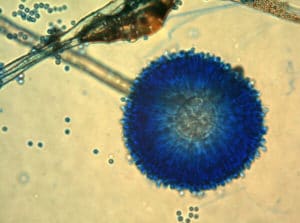
The Department of Energy has its eyes on an unassuming solution to our bioenergy needs: Aspergillus. The fungal genus contains hundreds of variations, which include powerful pathogens, industrial cell factories, and prolific producers of bioactive secondary metabolites.
The DOE’s Joint Genome Institute (JGI) has embarked on an ambitious plan to sequence, annotate and analyze the genomes of 300 Aspergillus fungi, and the first results are in.
In a study published in the Proceedings of the National Academy of Sciences, “Linking secondary metabolites to gene clusters through genome sequencing of six diverse Aspergillus species,” a team led by researchers at the JGI in partnership with the DOE’s Joint BioEnergy Institute (JBEI) and the Technical University of Denmark (DTU), describe how they applied SMRT Sequencing to four diverse Aspergillus species (A. campestris, A. novofumigatus, A. ochraceoroseus, and A. steynii), producing very high-quality genome assemblies that can serve as reference strains for future comparative genomics analyses.
Two additional strains (A. taichungensis and A. candidus) were also sequenced and a comparative analysis involving these and other Aspergillus genomes was then conducted, allowing the team to identify biosynthetic gene clusters for secondary metabolites (SMs) of interest.
“One of the things we found to be interesting here was the diversity of the species we looked at; we picked four that were distantly related,” says study senior author Mikael R. Andersen, Professor at DTU. “With that diversity comes also chemical diversity, so we were able to find candidate genes for some very diverse types of compounds.”
Using a new analysis method developed by first author Inge Kjaerboelling, the team looked for genes found in all producer species and was able to “elegantly pinpoint the genes,” Andersen adds.
Among the traits they traced were allergens, virulence, and pathogenicity. Aspergillus fungi are also known to contain more than 250 carbohydrate active enzymes (CAzymes), which break down plant cell walls. Knowledge of how this works could help the DOE as it pursues sustainable alternative fuels using bioenergy feedstock crops.
The fungal species’ secondary metabolites are also of interest to DOE researchers, as these small molecules have the potential to act as biofuel and chemical intermediates. Determining the structures of purified secondary metabolites is often relatively straightforward, but connecting these molecules to their biosynthetic pathways can be quite challenging, says study co-author Scott Baker, a fungal researcher at the Environmental Molecular Sciences Laboratory, a DOE Office of Science User Facility located at the Pacific Northwest National Laboratory.
“We show that using comparative genomics can efficiently lead to reasonable predictions of gene clusters involved in biosynthetic pathways,” Baker says.
The authors hope that by characterizing the identity and roles of secondary metabolites, and the genes necessary for their generation, they will discover potential tools for improving the ability to process recalcitrant biomass into precursors for biofuels and bioproducts.